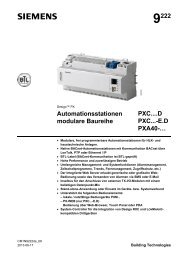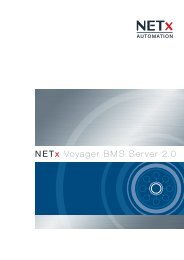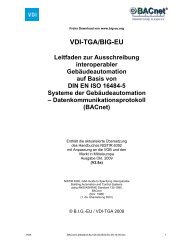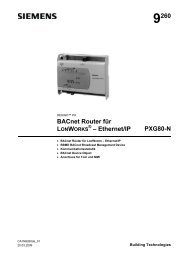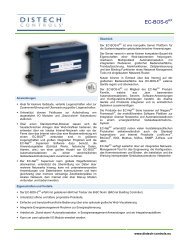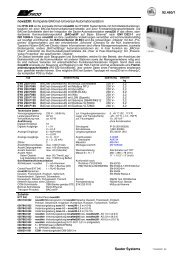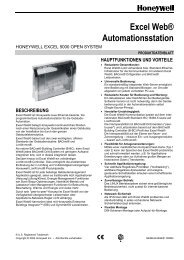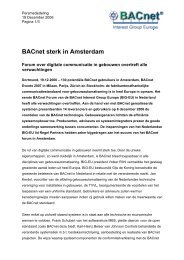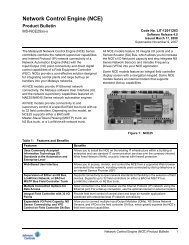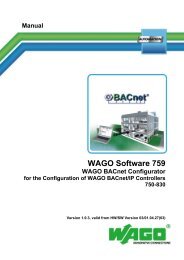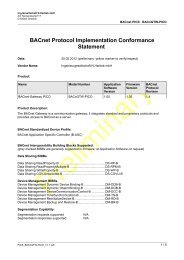Journal - BACnet Interest Group Europe eV
Journal - BACnet Interest Group Europe eV
Journal - BACnet Interest Group Europe eV
Erfolgreiche ePaper selbst erstellen
Machen Sie aus Ihren PDF Publikationen ein blätterbares Flipbook mit unserer einzigartigen Google optimierten e-Paper Software.
Leittechnik durch die Richtlinien<br />
zur energieeffizienten Funktionalität,<br />
den Überprüfungs-Mechanismen<br />
und – das ist vielleicht das<br />
Wichtigste von allem – durch regelmäßige<br />
Inspektionen vor Ort.<br />
BIG-EU and eu.bac have the same<br />
goals. They contribute significantly<br />
to achieving the <strong>Europe</strong>an<br />
Energieeffizienziele - by providing<br />
a basis to facilitate the use of high<br />
quality building automation and<br />
building on. In this article, eu.bac<br />
before their certification system.<br />
A plan for promoting improved<br />
energy efficiency of Building Automation<br />
and Control Systems<br />
(BACS) with the help of existing<br />
EN Standards and a new eu.bac<br />
Certification Scheme has been developed<br />
by, the <strong>Europe</strong>an Building<br />
Automation and Controls Association.<br />
Improved energy efficiency in<br />
buildings is a high priority among<br />
<strong>Europe</strong>an decision makers, as<br />
well as building owners and<br />
eu.bac members. Presently there<br />
is one <strong>Europe</strong>an standard that<br />
assists building owners to ensure<br />
that a new building being built, or<br />
an existing building being refurbished,<br />
will have the best available<br />
BACS technology to save<br />
energy – i.e. the EN 15232 – Energy<br />
performance of buildings –<br />
Impact of Building Automation,<br />
Controls and Building Management<br />
standard. However, there<br />
are no standards available that<br />
address the difficult challenge of<br />
building owners to ensure that<br />
their buildings keep performing<br />
as well over time, or better, than<br />
when they were first commissioned.<br />
The new eu.bac Certification<br />
Scheme has been developed to advance<br />
the state of the art in energy<br />
efficiency of BACS in buildings<br />
and specifically provides certifying<br />
energy performance of BACS<br />
in buildings, at the first delivery<br />
and during the lifetime.<br />
EPBD and EN 15232<br />
The Energy Performance of<br />
Buildings Directive (EPBD) was a<br />
very important step in the effort<br />
of the <strong>Europe</strong>an Union to improve<br />
the energy efficiency of the large<br />
building stock in <strong>Europe</strong>.<br />
As a result of the EPBD about 40<br />
EN standards were developed to<br />
harmonize the energy calculation<br />
methods concerning buildings.<br />
EN 15232 is the standard<br />
that concerns the energy impact<br />
of building automation, controls<br />
and building management.<br />
eu.bac Certification<br />
Today eu.bac provides certification<br />
of products to various applicable<br />
EN standards concerning<br />
Building Automation. This is<br />
available for individual zone controllers<br />
and will shortly be available<br />
for heating controllers and<br />
sensors. Certifications of more<br />
types of products are planned.<br />
The goal of the certification is to<br />
assure energy efficient functionality<br />
provided by the products.<br />
Certification of energy performance<br />
of products is very important<br />
but will not be possible for<br />
all types of products used in a<br />
BACS installation; neither will it<br />
cover the system wide aspects of<br />
energy efficient control of a building.<br />
That is were the new eu.bac<br />
certification of BACS will play an<br />
important role.<br />
Certification Procedure<br />
for Systems<br />
The procedure for eu.bac certification<br />
is designed as a three step<br />
process:<br />
1. Self-Declaration<br />
of the basicBACS system<br />
The first step is a self-declaration<br />
by the provider of BACS that a<br />
particular system is capable of<br />
delivering the functionality described<br />
in the Technical Recommendations.<br />
For a manufacturer<br />
of BACS this will typically be<br />
a self-declaration for a specific<br />
product family, while for a systems<br />
integrator it may be for the<br />
mix of products that is provided.<br />
The self-declarations will be<br />
made available in the eu.bac website.<br />
Never-the-less it must be understood<br />
that a BACS only can<br />
provide such functionality where<br />
the corresponding physical equipment<br />
has been installed and is<br />
working properly, e.g. presence<br />
detectors must be present to provide<br />
demand based control.<br />
2. Certification of<br />
a specific BACS installation<br />
The second step is the certification<br />
of a BACS installation in a<br />
specific building. This is done<br />
by an authorized inspector who<br />
makes a site visit. As a starting<br />
point for the inspection the inspector<br />
should receive a check-list<br />
prepared by the building owner<br />
or maybe more often by the systems<br />
integrator. The purpose of<br />
the inspection is to verify that<br />
the claimed functionality is available<br />
in the building and that it is<br />
functional. The performance of<br />
the functions is not evaluated in<br />
this step because there is normally<br />
no historical measurement data<br />
available.<br />
3. Periodic inspection of the<br />
BACS installation<br />
The third step is the periodic inspection<br />
of the BACS installation.<br />
This is to verify that the certified<br />
functionality is still available and<br />
working properly. If this is not<br />
the case the inspector will notify<br />
eu.bac who will require the<br />
building owner to recertify the<br />
installed BACS, or the certificate<br />
will be withdrawn.<br />
However, the main purpose of the<br />
periodic inspection is to evaluate<br />
the energy performance of the<br />
BACS, and of the building as a<br />
whole. This is done with the help<br />
of performance indicators and<br />
key performance indicators that<br />
will help understanding the performance<br />
of the installed systems.<br />
The periodic inspection helps<br />
counteract the fact that systems<br />
have a tendency to deteriorate in<br />
terms of energy performance unless<br />
they are maintained properly.<br />
This is an inherent issue because<br />
of the analog and mechanical nature<br />
of the installed systems.<br />
Technical Recommendations<br />
The basis for the certification is<br />
the above mentioned standard EN<br />
15232. For the purpose of certification<br />
the requirements from EN<br />
15232 are described in a Technical<br />
Recommendations document,<br />
which explains how to interpret<br />
and inspect EN 15232 functionality.<br />
It contains detailed descriptions<br />
of each function: Target of<br />
the function, conditions, different<br />
operating modes, what the inspector<br />
should check, etc.<br />
Relationship with other<br />
classification systems<br />
Additionally the Technical Recommendations<br />
explains the relationship<br />
between the functionality<br />
described and similar functionality<br />
described in other – wider –<br />
classification systems, e.g. LEED,<br />
HQE, BREEAM, etc. This simplifies<br />
the process if the building<br />
is also submitted to any of these<br />
classification systems.<br />
<strong>BACnet</strong> insight<br />
Performance Indicators<br />
An important part of the eu.bac<br />
Certification Scheme is the description<br />
of performance indicators.<br />
They are values from the<br />
operational data of a BACS that<br />
give information about the energy<br />
efficiency of a specific part of the<br />
BACS component or function. An<br />
evaluation of these values over a<br />
certain observation period may be<br />
used to understand the efficiency<br />
of the BACS component or function.<br />
They are defined from the<br />
room level, equipment level and<br />
up to the building level in such a<br />
way that they can be implemented<br />
in any BACS from any vendor.<br />
Opportunities<br />
The eu.bac certification scheme<br />
serves the purpose of helping<br />
building owners to put the right<br />
requirements for energy saving<br />
measures to be delivered in their<br />
installations of BACS. It helps<br />
them (or their consultant) to specify<br />
best practice energy saving<br />
measures to an extent that they<br />
are willing to pay for– i.e. to set<br />
expectations at the right level.<br />
When the building has been built<br />
it also helps the building owner<br />
to verify that the specified functionality<br />
of the BACS actually has<br />
been implemented in his building,<br />
and that it works, not only<br />
initially but over the life-time of<br />
the system. Ultimately, this allows<br />
the building owner to save money<br />
on energy expense and makes the<br />
building more valuable and marketable.<br />
Additionally it provides a visual<br />
evidence of the energy performance<br />
quality of the building control<br />
system in his building.<br />
Altogether it is a very strong message<br />
to the market that should<br />
help manufacturers and system<br />
integrators to provide more energy<br />
saving measures and services,<br />
to the benefit of the environment.<br />
Summary<br />
The eu.bac Certification Scheme<br />
promotes improved energy efficiency<br />
of Building Automation<br />
and Control Systems because it<br />
provides guidelines to energy efficient<br />
functionality, provides a<br />
mechanism to check that a BACS<br />
installation actually includes the<br />
expected functionality, and that<br />
– maybe most important of all<br />
– with periodic inspections the<br />
functionality provides equal or<br />
better performance over time.<br />
<strong>BACnet</strong> <strong>Europe</strong> <strong>Journal</strong> 14 03/11 43




